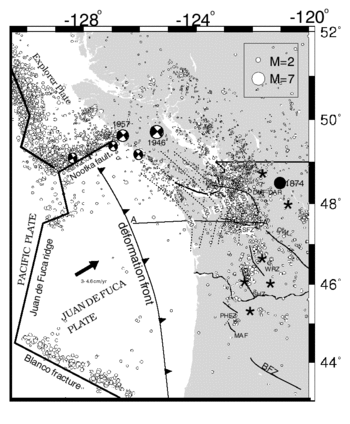Triple junction
A triple junction is the point where the boundaries of three tectonic plates meet. At the triple junction each of the three boundaries will be one of 3 types - a ridge (R), trench (T) or transform fault (F) - and triple junctions can be described according to the types of plate margin that meet at them (e.g. Transform-Transform-Trench, Ridge-Ridge-Ridge, or abbreviated F-F-T, R-R-R). Of the many possible types of triple junction only a few are stable through time ('stable' in this context means that the geometrical configuration of the triple junction will not change through geologic time).
History
The first scientific paper detailing the triple junction concept was published in 1969 by W. Jason Morgan, Dan McKenzie, and Tanya Atwater.[1] The term had traditionally been used for the intersection of three divergent boundaries or spreading ridges. These three divergent boundaries ideally meet at near 120° angles.
In plate tectonics theory during the breakup of a continent, three divergent boundaries form, radiating out from a central point (the triple junction). One of these divergent plate boundaries fails (see aulacogen) and the other two continue spreading to form an ocean. The opening of the south Atlantic Ocean started at the south of the South American and African continents, reaching a triple junction in the present Gulf of Guinea, from where it continued to the west. The NE-trending Benue Trough is the failed arm of this junction.[2]
In the years since, the term triple-junction has come to refer to any point where three tectonic plates meet.
Examples


- The junction of the Red Sea, the Gulf of Aden and the East African Rift centered in the Afar Triangle (the Afar Triple Junction) is the only Ridge-Ridge-Ridge (R-R-R) triple junction above sea level.
- The Rodrigues Triple Point is a R-R-R triple junction in the southern Indian Ocean, where the African, the Indo-Australian and the Antarctic Plates meet.[3]
- The Galapagos Triple Junction is an R-R-R triple junction where the Nazca, the Cocos, and the Pacific Plates meet. The East Pacific Rise extends north and south from this junction and the Galapagos Rise goes to the east. This example is made more complex by the Galapagos Microplate which is a small separate plate on the rise just to the southeast of the triple junction.
- Chiapas coast off Tapachula where Guatemala, North America and Pacific join and small earthquakes occur weekly. This is pushed eastward by the Cocos plate.
- On the west coast of North America is another unstable triple junction offshore of Cape Mendocino. To the south, the San Andreas Fault, a strike-slip fault and transform plate boundary, separates the Pacific Plate and the North American Plate. To the north lies the Cascadia subduction zone, where a section of the Juan de Fuca Plate called the Gorda Plate is being subducted under the North American Plate, forming a trench (T). Another transform fault, the Mendocino Fault (F), runs along the boundary between the Pacific Plate and the Gorda Plate. Where the three intersect is the seismically active, F-F-T Mendocino Triple Junction.
- The Amurian Plate, the Okhotsk Plate, and the Philippine Sea Plate meet in Japan near Mt. Fuji. (see Mount Fuji's Geology)
- The Azores Triple Junction is a geologic triple junction where the boundaries of three tectonic plates intersect: the North American Plate, the Eurasian Plate and the African Plate, R-R-R.
- The Boso Triple Junction offshore Japan is a T-T-T triple junction between the Okhotsk Plate, Pacific Plate and Philippine Sea Plate.
- The North Sea is located at the extinct triple junction of three former continental plates of the Palaeozoic era: Avalonia, Laurentia and Baltica.[4]
Interpretation
The properties of triple junctions are most easily understood from the purely kinematic point of view where the plates are rigid and moving over the surface of the Earth. No knowledge of the Earth's interior or the geological details of the crust are then needed. Another useful simplification is that the kinematics of triple junctions on a flat Earth are essentially the same as those on the surface of a sphere. On a sphere, plate motions are described as relative rotations about Euler Poles (see Plate reconstruction), and the relative motion at every point along a plate boundary can be calculated from this rotation. But the area around a triple junction is small enough (relative to the size of the sphere) and (usually) far enough from the pole of rotation, that the relative motion across a boundary can be assumed to be constant along that boundary. Thus, analysis of triple junctions can usually be done on a flat surface with motions defined by vectors.
See also
References
- ↑ McKenzie, D. P.; Morgan, W. J. (11 October 1969). "Evolution of Triple Junctions". Nature. Nature Publishing Group. 224 (5215): 125–133. Bibcode:1969Natur.224..125M. doi:10.1038/224125a0.
- ↑ S. W. Petters (May 1978). "Stratigraphic Evolution of the Benue Trough and Its Implications for the Upper Cretaceous Paleogeography of West Africa". The Journal of Geology. 86 (3): 311–322. Bibcode:1978JG.....86..311P. doi:10.1086/649693. JSTOR 30061985.
- ↑ Sauter, D.; Mendel, V.; Rommeveaux-Jestin, C. (1997). "Propagation of the Southwest Indian Ridge at the Rodrigues Triple Junction". Journal Marine Geophysical Researches.
- ↑ White, N.; Latin, D. (1993). "Subsidence analyses from the North Sea 'triple-junction'" (PDF). Journal of the Geological Society. The Geological Society. 150 (3): 473–488. doi:10.1144/gsjgs.150.3.0473.
- Oreskes, Naomi, ed., 2003, Plate Tectonics: an Insider's History of the Modern Theory of the Earth, Westview Press, ISBN 0-8133-4132-9